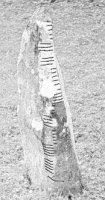For the location and discovery, cf. {148}.
Size according to Brash, OIM 209: 4'6" x 1'3" x 8"
Size according to Macalister, CIIC: 4'2" x 1'3" x 0'8"
Published illustrations:
- Brash, OIM pl. XXVI, no. 2 (draft)
- Macalister, CIIC I, 145 (draft)
Reading Brash, OIM 209 (no. 2):
Left angle:
пвононедонегннедв
MAQQIQETTIA
Right angle:
пвононедомдтседннед
MAQQICURITTI
"THE SON OF CUETTI - THE SON OF CURITT"
The stone "appears to commemorate two individuals" (it is also mentioned as "Ballinrannig" in Brash, JRSAI 10, 1869, 260 as commmemorating "more than one individual"; cf. {106}). - The "terminal A" of the first line is omitted by Ferguson; this author further read Cunitti instead of Curitti which might be due to the fact that he read from a cast: "Owing to a fracture of the stone, the angle shifts, and the inscription follows the angle; the cast does not show this divergence". The reading with R is further supported by the names "Ritt and Curitt and Rettos" appearing on other stones. - "The first name probably reads Cetti, as Q is frequently used for C; we find Ceat Mac Magach in the pre-historic period, as Cat" in `Tribes and Customs of Hy. Maine', 83; "Caette and Caetti in Mart.Don. pp. 284, 375. The Catti were a tribe of North Britain". Cf. Ballintaggart no. 3 {157}.
MAQQICUNITTI
MAQQIQITTI
This "follows the example of the Gortnegullanagh example {184}, giving apparently only the patronymics".
Left:
пвононедонегннедв
MAQQIQETTIA
Right:
пвононедомдкйедннед
MAQQICUNITTI
"I saw no reason for rejecting the final a of the first line; as for the n in the second, it is certainly not r .. as the B-surface is here very narrow, this letter has been prolonged by carrying it across the adjacent angle." - "A masculine of the feminine *Qettis meets us at Drumconwell (Armagh) {311}, where we have maqi Qetai, which Professor RhЯs connects with the Middle-Irish Cet." The Q speaks against this name being "the base of Cattini, found in this cemetery" {153}. Cunittos "is a derivative from Cun-, found in its simple form at both Ballinrannig {154} and Ballintaggart {162; both read CUNAMAQQI}; "similar names are Curc-itt- {160: Ballintaggart}, Cass-itt- {81: Garranes}. It is the Middle-Irish Connait."
Up-up:
MAQQI-QETTI MAQQI CUNITTI
"There is a faint, broad, hollow notch after QETTI .., not nearly as deep as the I-notches preceding it. It might be A, but I am inclined to reject it. In the second line, the N looks at first like an R."
MAQQI QETTI MAQQI CUNITTI
The reading is undisputed. The inscription belongs to the early period.
MAqQI QETTIa MAQQI CUNITTI m..
Reading Gippert (1978):
 Dexter angle up ||
Dexter angle up ||  sinister angle up:
sinister angle up:
MAQQI QETTI[A] || MAQQI CU[N]ITTI
пвононедонегннед[в] || пвононедомдкйедннед
пвлллллжлллллвввввлллллввввлллжлллввввв[в] || пвлллллжлллллвввввллллввв зззззвввввлллжлллввввв
It cannot be decided with certainty whether the final notch on the dexter angle was intended, as an A, or not. - The reading of the sinister angle is difficult because the inscribed angle coalesces with the one to its right at the place of the presumed N so that the characters following after the N are arranged relative to the right angle. Like this, the N could be read as a Q instead (but certainly not as a R), in accordance with the T characters following (and note that its fifth score is shorter than the following vowel scores!). In the latter case, the inscription on the sinister angle looks like an attempt of repeating the one of the dexter angle: *MAQQI CU - QITTI; the I in QITTI is certain here, however.
Last changes of this record: 27.04.97
Copyright Jost Gippert, Frankfurt a/M 1996. No parts of this document may be republished in any form without prior permission by the copyright holder.  Dexter angle up ||
Dexter angle up ||  sinister angle up:
sinister angle up:



